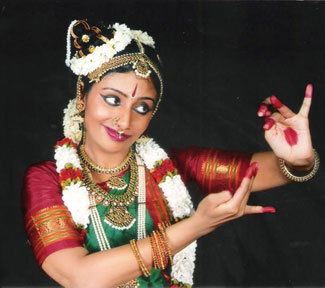Use of hand gestures in Indian classical dances
By Subashini Pathmanathan
All Indian and oriental Classical dances are mostly based on Natya
Sathra.
The muthras or hand gestures in Bharatha Natyam and some of the other
South Indian classical dance forms play important role. The word muthras
or hasthas generally means the figure works of the fingers.
The muthras are generally divided into two major categories. One is
single hand muthras, and other one is double hand muthras. Number of
muthras; generally differ from text to text. Generally there are 28
single hand muthras, and 23 double hand muthras. Two or three different
types of muthras are illustrated under one name.
In Sanskrit the muthras are called Hasthas, and single hand muthras
are called Asamutha Hasthas, and double hand muthras are called Samutha
Hasthas. Yet the total number of muthras differ from text to text.
 |
|
Classical Indian dancer
|
In some texts the total numbers of single hand muthras are about
thirty to thirty three and the double hand muthras are nearly about 23.
Even the muthras are referred as Kai Ammaithi in Tamil. Both these
single hand muthras and double hand muthras are further divided, into
two different categories.
One is Ellil hand muthras, (beauty hands, or grace hands).And other
is Thollil hand muthras (working hands), to illustrate the meaning of
the songs. Ellil hand muthras are used only in adavus (steps).This
category of Ellil hand muthras are only used in the nirtha division of
dance.
That's why these hands are often called nirtha muthras or nirtha
hasthas. These hands do not reveal any meaning but add beauty to the
hands. More or less altogether 13 muthras are included in this category,
including some single hand muthras, and some double hand muthras.
The muthras used for abinaya are called Nirthiya hasthas, or Nirthiya
muthras. In this category all the single and double hand muthras are
used.
Each muthras has numerous usages. The usages of each muthras are
clearly described in various ancient texts. Yet in Bharatha Natyam and
in other South Indian classical dances we still use these muthras with
the same sense and effect with the same prescribed illustrations in
texts.
In these classical dance forms certain muthras (hand gestures) are
firmly established for certain concepts like asuras, devas, different
deities, mother, father, uncle aunt, different planets and the ten
incarnations of lord Vishnu.
In the Indian classical dance forms Kathakali, Kuchupidi, Oddissi,
and Mohini Attam use the same hasthas, or muthras.Only a restricted
number of muthras are used, in some Indian classical dance forms among
all these classical dance forms, Bharatha Natyam and Kuchupidi use the
maximum number of muthras.
Normally the role of muthras is not clearly and firmly demarcated
within a chosen limit. Practically the use of muthras is totally
depended on the imaginative creativity of each individual artiste, and
the personal ability of the artiste, and how the artiste interprets the
meaning of the songs.
In Kathakali the muthras are used on the basis of the ancient text
Hastha Lakshana Deepika. Altogether more or less 24 fundamental muthras
are used in Kathakali. Like most of the other Indian classical forms, in
Kathakali the meaning of the songs, (moods and emotions) are
illustrated, expressed and interpreted through facial expressions and
hand gestures (hasthas).
In Oddissi, like Bharatha Natyam, hasthas or hand gestures are used
in pure nirtha and nirthiya. Abinaya Darpana is the ancient Sanskrit
text believed to be written by Nanthikeswarar which is the main source
to learn the hand gestures.
Beside this, various treatises are available to provide, valuable
information regarding the hand gestures. Like Bharatha Natyam, and
Kathakali, Oddissi, also derives its hand gesture sources from Abinaya
Darpanam, to some extent, but mostly it derives from Abinaya Chandrika.
The Andhra Pradesh classical dance form Kuchupidi, has its close
links with Tamil Nadu classical dance form Bharatha Natyam. Hence both
these classical dance forms use the hand muthras extensively in nirtha
and nirthiya. Kuchupidi is more drama based classical dance form, which
uses more realistic expressions in the dance, while interpreting the
meaning of the theme of the songs through facial expression and hand
gestures.
Mohini Attam which is another attractive classical dance form is a
fusion of Bharatha Natyam and Kathakali; it also uses the same hand
gestures to a great extent. Many times various varieties of folk dances
are used in numerous traditional hand gestures to interpret the meaning
of the songs.
Another division of hand gestures is called sculptural muthras. These
sculptural hasthas (gestures) or sculptural muthras look almost similar
to dance muthras. Even the dance muthras derive their source from the
sculptural muthras. But essentially and basically the usage of the
sculptural muthras differs from the dance muthras.
The gopura temple sculptural muthras are used to interpret the
meaning of the epics, and religious puranas. Meanwhile in dance the
poses and abinaya are used to interpret the meaning of the songs through
muthras. The sculptural muthras are carved in stones, or made out of
combined mixture of cement; hence the shapes are quite different from
the natural dance hand muthras.
|

